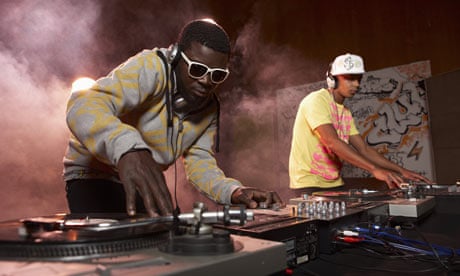What is it? An umbrella term used to define an attitude and set of techniques particular to a DJ using turntables and mixers as music-creating instruments in themselves rather than purely as devices to play music.
Who uses it? Key figures in hip-hop turntablism history include Kool DJ Herc (pioneer of "cutting", the first true turntablism), Grand Wizard Theodore (inventor of scratching), Grandmaster Flash (the first to record scratching), GrandMixer D.ST (who popularised scratching), Jazzy Jeff and Cash Money (pioneers of "transforming"), Steve Dee (master of "beat juggling"), Rob Swift and Roc Raida, MixMaster Mike and DJ Qbert, Run DMC's Jam Master Jay, Cut Chemist, DJ Shadow and more, documented in our Spotify playlist. Outside of hip-hop, the manipulation of turntables has also featured prominently in musique concrete, where work by John Cage and Christian Marclay actually predates hip-hop turntablism.
How does it work? Cutting involves isolating the "break" in funk records – the seconds-long climax where the tune would strip right down to an infectious, danceable clatter of percussion. Kool Herc would have two copies of the same single playing at the same time, alternately rewinding and flipping between the two to extend the break indefinitely. Scratching is the distinctive flutter and scrawl of sounds in hip-hop made by the DJ moving a record back and forth under the needle with his or her fingertips. Beat juggling is a rhythmically complex on-the-fly rearrangement of beats from two records into entirely new patterns – effectively making the turntables into an analogue, fingertip-operated sampler.
Where does it come from? Block parties in mid-1970s New York and Philadelphia established the DJ at the heart of hip-hop. At that stage, MCs were employed solely to big-up the already fiercely competitive skills of their DJ. By the mid-1980s, though, affordable samplers and drum machines had replaced the DJ in the rap combo, and rapper-as-auteur MCs were now the star. DJs, though, continued to hone and expand the language of scratching and other techniques in garage parties and on mixtapes. The arrival of The Return of the DJ compilation in 1995 signified a major seachange in hip-hop – the first-ever all-DJ/no-MC album. By now, supergroup virtuoso crews like Invisible Skratch Piklz and X-ecutioners were establishing instrumental hip-hop as a viable artform, and the movement had a new, baiting name courtesy of DJ Babu, who proudly proclaimed himself to be a "turntablist" rather than a DJ – a musician, the hip-hop equivalent to a lead guitarist.
Why is it classic? Check out any footage from the insane DMC World Championships. Each turntablist spends up to a year honing a six-minute showcase of their skills to perfection and it emphasises the level of talent, knowledge, and, yes, musicianship required to shine in what must be not only hip-hop's – but music in general's – most competitive arena.
What's the best ever turntablist song? Doug Pray's excellent documentary on turntablism, Scratch, asserts that it was GrandMixer D.ST's near-lyrical work on Herbie Hancock's Rockit that convinced every existing turntable star to take up the decks.
Five facts and things
* So how does anyone come up with the idea of rubbing a record about under a needle to create a brain-scratching racket? Credit Grand Wizard Theodore's mum! The Grandmaster Flash protege was keeping the family awake one night, incessantly refining his DJing, when his mum burst through the door and yelled at him to shut up. Grabbing the vinyl to halt the music, rather than killing the turntable motor, Theodore instantly loved the sound, and spent a couple of months working out a technique before exhibiting his new gimmick at parties and shows.
* From those earliest vinyl-desecrating experiments, turntablists have developed scratching to the extent where it not only has its own form of musical notation, but can be divided into a multiplicity of schools and techniques. Here are examples of baby, tear, scribble, chirp, transformer, flare, crab, twiddle, orbit and euro.
* The youngest ever winner of the DMC was Kanye West's DJ, A-Track, who clinched the international title in 1997, aged just 15. The current youngest superstar turntablist? That would be DJ A-Kidd, who began his career aged FIVE, and who, now at a practically geriatric seven, is invited to scratch at turntablist events around the world.
* What does DMC stand for? Disco Mix Club. The tournament began in 1986 as a general contest for disk jockeys. The following year, a British DJ, Cheese, introduced the competition to scratching, sufficiently flooring his competitors to win the world contest. With the newfound attention scratching brought to the contest, the event became a hip-hop-only battle.
* Although Grandmaster Flash's seminal The Message is the first record to exhibit hip-hop scratching, some credit Creedence Clearwater Revival (!) and their 1968 song Walk On the Water as the first instance of a scratching-type turntable sound effect on a record.
